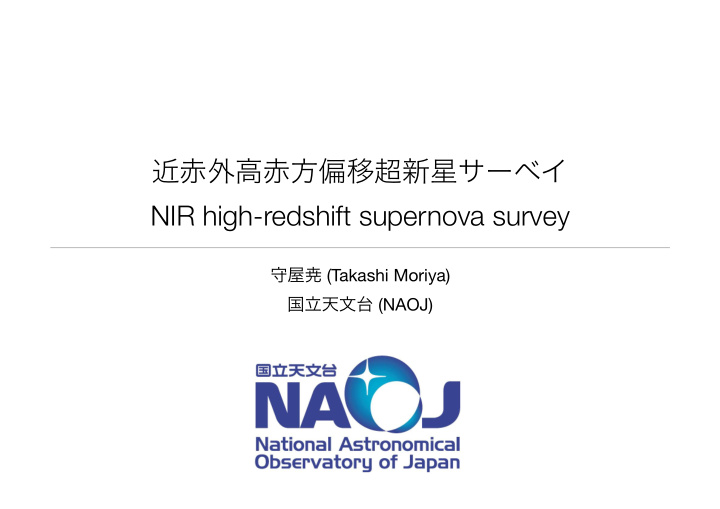



近赤外高赤方偏移超新星サーベイ NIR high-redshift supernova survey 守屋尭 (Takashi Moriya) 国立天文台 (NAOJ)
High-redshift supernova survey with HSC in optical HSC SSP transient survey • we found a SN at z = 2.4 (the second most distant SN ever found) • HSC discovery -> Keck/LRIS spec. follow-up • optical transient surveys can reach z ~ 4 (Tanaka, Moriya et al. ’12) • 2500 2000 total SLSN rate (Gpc -3 yr -1 ) 1500 1000 500 Cooke et al. (2012) Quimby et al. (2013) Prajs et al. (2017) 0 0 0.5 1 1.5 2 2.5 3 3.5 4 4.5 redshift Moriya et al. (2019), Curtin et al. (2019)
2020s : Era of NIR transient surveys Many NIR wide-field imagers are planned enabling us to discover high-redshift supernovae. WFIRST: wider field, in space ULTIMATE: accessible up to 2.3µm
Searching for pair-instability supernovae Pair-instability supernova (PISN) Supernovae that most easily explode theoretically. Predicted in 1960s. Explosions of massive stars with the He cores between ~ 65 Msun and ~ 135 Msun Corresponds to the ZAMS mass between ~ 150 Msun and ~ 250 Msun when there is no mass loss Langer (2012)
Searching for pair-instability supernovae PISNe : need to have massive He core to explode when metallicity is high, mass loss prevents massive He core formation
Searching for pair-instability supernovae PISNe : need to have massive He core to explode when metallicity is high, mass loss prevents massive He core formation First stars 1. no metals, almost no mass loss 2. many massive stars are predicted to form (top heavy IMF) first stars between 150 Msun and 250 Msun should explode as PISNe Hirano et al. (2015) first star IMF high-redshift SN survey = NIR transient survey
Searching for pair-instability supernovae PISNe can produce a lot of radioactive 56Ni and become very luminous “hypernovae” : produce 0.5 - 1 Msun of 56Ni PISNe : ~ 50 Msun or more 56Ni can be synthesized at most Moriya et al. (2019)
Survey strategy one epoch / half year is enough to discover PISNe at z > 6 • to reach z > 6 where Pop III star formation occurs, we need 26.5 • mag/epoch Moriya et al. (2019)
Survey strategy if we cover 1 deg2 with ULTIMATE (14’ x 14’) down to K = 26.5 mag • every half year.. 70 hours/epoch (~ 9 nights/epoch) • if we conduct 5 year survey, 700 hours (~ 90 nights) are required. • we can also get very deep K band image for 1 deg2!! •
Discovering PISNe from the first stars survey simulation by assuming de Souza et al. (2014) Pop III SFR • Moriya et al. (2019)
Discovering PISNe from the first stars Moriya et al. (2019)
Discovering PISNe from the first stars Moriya et al. (2019)
Discovering PISNe from the first stars Moriya et al. (2019)
Discovering PISNe from the first stars • expected numbers increase if we conduct the survey towards the clusters of galaxies thanks to the gravitational lensing Wong et al. (2019)
Spectroscopic follow-up observations TMT, JWST… • good candidate selection method required • simultaneous optical observations with HSC and/or WFIRST • host galaxy information •
LTAO + X-Shooter-like spectrograph on Subaru? D-Shooter (Daughter of X-Shooter) — “ultimate” spectrograph •
LTAO + X-Shooter-like spectrograph on Subaru? D-Shooter (Daughter of X-Shooter) — “ultimate” spectrograph • started to talk with X-Shooter project scientist Your input will be highly appreciated!
うまい LTAO + X-Shooter-like spectrograph on Subaru? if we make a copy of X-Shooter by collaborating with ESO • cost: ~ 300 M JPY • GLAO commissioning at ~ 2026 • やすい はやい
Summary ~ 90 nights with ULTIMATE • a few PISNe at z > 6 • very deep K band image in K band • Moriya et al. (2019)
Recommend
More recommend